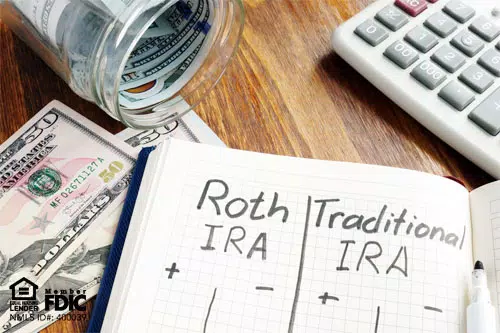If you want a substantial nest egg for retirement, it's essential to start saving as early as possible. IRAs (Individual Retirement Accounts) are one vehicle you can use to help save money while still in the workforce. There are two main types of IRAs: Roth and Traditional IRAs.
When choosing which type of account is right for your retirement savings needs, it is important to understand how each works, how they differ, and what your preferences are. Below is an overview of Roth and traditional IRAs to help you make your choice.
What is a Traditional IRA?
Traditional IRAs provide upfront tax deductions to savers, which can be particularly attractive for those seeking to lower their present tax bill. They also allow you to grow your investment tax-deferred, similar to how a 401(k) works. A traditional IRA might also be the right choice if you expect your tax rate will be reduced upon retirement.
The contribution limit for traditional IRAs is $6,000, or $7,000 if you are over 50 in 2019. You can continue to make contributions until you are 70 and a half. You may qualify for a tax deduction for the year you contribute, but you still fund your account.
Since your investments are tax-deferred, you won't be taxed on the gains until you withdraw. If you make withdrawals earlier than the minimum age requirement of 59 and a half or don’t meet other conditions for early withdrawals, you will pay a 10% penalty. There is also a required minimum distribution that starts when you turn 70 and a half. All the retirement distributions are considered ordinary income and are taxed.
What is a Roth IRA?
Roth IRAs are very similar to traditional IRAs, as they both offer a wide variety of investment options and have the same contribution limits. The difference is that contributions to a Roth IRA are after-tax dollars. Because you have paid the taxes, distributions from a Roth IRA are free from penalties and taxes.
Your distributions must meet specific qualifications to avoid penalties or paying taxes on withdrawal transactions. The distribution cannot be taken earlier than five years from when you first funded the account, with the fifth-year period beginning the tax year of the first contribution made. Additionally, one of the following requirements must also be met:
- You are 59 and a half years old
- Have a disability
- A beneficiary or beneficiaries receive your distribution when you pass away.
- The distribution is used to purchase a first home (a lifetime limit of $10,000 could apply)
If you expect your retirement tax rate to be higher than yours, Roth IRAs are generally the better choice. This is because Roth IRAs pay taxes in the present.
Roth IRAs do not have a required minimum distribution like traditional IRAs. So, choosing when to use your money is up to you.
Choosing Between a Roth or Traditional IRA
The biggest difference between the two types of IRAs is the time frame you get your tax break. Traditional IRAs allow you to take a tax break the year you contribute, whereas Roth IRA withdrawals are not taxed. Also, check into whether you can anticipate a higher or lower tax rate when you retire.
The IRS rules regarding your IRA eligibility could also determine which type of IRA you choose. Your income level may limit your eligibility to contribute to a Roth IRA if you are a high-income individual. Your income will also determine how much you can contribute to a traditional IRA and deduct from your taxes. Also, if you or your spouse have access to a 401(k) or another type of workplace savings plan, you may have restrictions on your IRA deductibility. Something else to be aware of is that you may contribute to both types of accounts in the same year as long as the total amount is not more than the allowable contribution limit.
Ready to open an IRA? NASB can help you get started or answer any additional questions at 800-677-6272.




